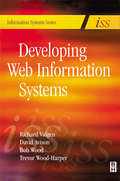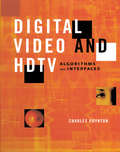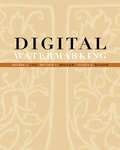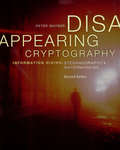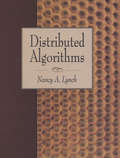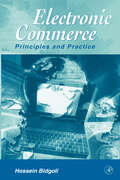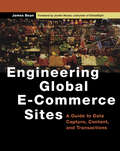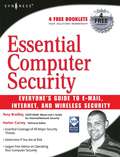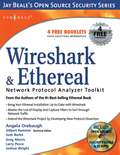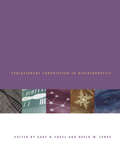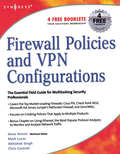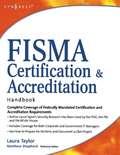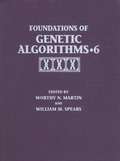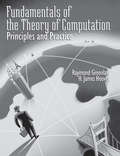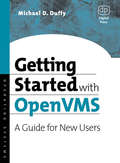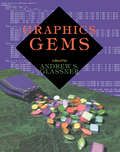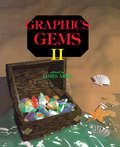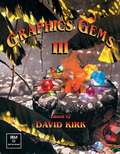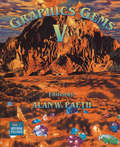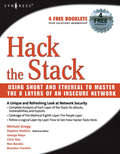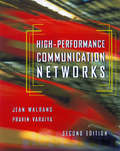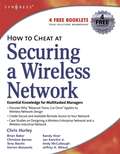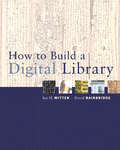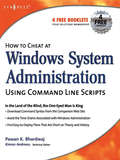- Table View
- List View
Developing Web Information Systems: From Strategy to Implementation
by Richard VidgenDeveloping Web Information Systems brings together traditional system development methods that have been taught for many years on information systems and computer science courses with web/e-commerce development. It is the first book to bring together IS development and the web applications in a thorough and systematic way. There is a running case study that illustrates web IS development from start to finish. The case is easy to understand (a theatre) and results in a working web application. Most, if not all, analysis and design texts fall short of making that step into software. The book draws heavily on practical experiences of web-based IS development resulting from commercial system development, so as well as appealing to students and academics, it will also interest practitioners. The coverage of data management and e-business strategy gives the book the broader scope essential for understanding IS development properly in an Internet context.First book to bring together IS development and web applications thoroughly and systematicallyCovers full development process from strategy, through analysis and design, to working softwareInteractive case study which can be accessed on author's website
Digital Video and HD: Algorithms and Interfaces (The Morgan Kaufmann Series in Computer Graphics)
by Charles PoyntonRapidly evolving computer and communications technologies have achieved data transmission rates and data storage capacities high enough for digital video. But video involves much more than just pushing bits! Achieving the best possible image quality, accurate color, and smooth motion requires understanding many aspects of image acquisition, coding, processing, and display that are outside the usual realm of computer graphics. At the same time, video system designers are facing new demands to interface with film and computer system that require techniques outside conventional video engineering.Charles Poynton's 1996 book A Technical Introduction to Digital Video became an industry favorite for its succinct, accurate, and accessible treatment of standard definition television (SDTV). In Digital Video and HDTV, Poynton augments that book with coverage of high definition television (HDTV) and compression systems.For more information on HDTV Retail markets, go to: http://www.insightmedia.info/newsletters.php#hdtvWith the help of hundreds of high quality technical illustrations, this book presents the following topics:* Basic concepts of digitization, sampling, quantization, gamma, and filtering* Principles of color science as applied to image capture and display* Scanning and coding of SDTV and HDTV* Video color coding: luma, chroma (4:2:2 component video, 4fSC composite video)* Analog NTSC and PAL* Studio systems and interfaces* Compression technology, including M-JPEG and MPEG-2* Broadcast standards and consumer video equipment
Digital Watermarking (The Morgan Kaufmann Series in Multimedia Information and Systems)
by Ingemar Cox Matthew Miller Jeffrey Bloom Mathew MillerDigital watermarking is a key ingredient to copyright protection. It provides a solution to illegal copying of digital material and has many other useful applications such as broadcast monitoring and the recording of electronic transactions. Now, for the first time, there is a book that focuses exclusively on this exciting technology. Digital Watermarking covers the crucial research findings in the field: it explains the principles underlying digital watermarking technologies, describes the requirements that have given rise to them, and discusses the diverse ends to which these technologies are being applied. As a result, additional groundwork is laid for future developments in this field, helping the reader understand and anticipate new approaches and applications.* Emphasizes the underlying watermarking principles that are relevant for all media: images, video, and audio.* Discusses a wide variety of applications, theoretical principles, detection and embedding concepts and the key properties of digital watermarks--robustness, fidelity, data payload, and security* Examines copyright protection and many other applications, including broadcast monitoring, transaction tracking, authentication, copy control, and device control.* Presents a series of detailed examples called "Investigations" that illustrate key watermarking concepts and practices.* Includes an appendix in the book and on the web containing the source code for the examples.* Includes a comprehensive glossary of watermarking terminology
Disappearing Cryptography: Information Hiding: Steganography & Watermarking (The Morgan Kaufmann Series in Software Engineering and Programming)
by Peter WaynerDisappearing Cryptography, Second Edition describes how to take words, sounds, or images and hide them in digital data so they look like other words, sounds, or images. When used properly, this powerful technique makes it almost impossible to trace the author and the recipient of a message. Conversations can be submerged in the flow of information through the Internet so that no one can know if a conversation exists at all.This full revision of the best-selling first edition describes a number of different techniques to hide information. These include encryption, making data incomprehensible; steganography, embedding information into video, audio, or graphics files; watermarking, hiding data in the noise of image or sound files; mimicry, "dressing up" data and making it appear to be other data, and more. The second edition also includes an expanded discussion on hiding information with spread-spectrum algorithms, shuffling tricks, and synthetic worlds. Each chapter is divided into sections, first providing an introduction and high-level summary for those who want to understand the concepts without wading through technical explanations, and then presenting greater detail for those who want to write their own programs. To encourage exploration, the author's Web site www.wayner.org/books/discrypt2/ contains implementations for hiding information in lists, sentences, and images.Each chapter is divided into sections, providing first an introduction and high-level summary for those who want to understand the concepts without wading through technical details, and then an introductory set of details, for those who want to write their own programs. Fully revised and expanded. Covers key concepts for non-technical readers. Goes into technical details for those wanting to create their own programs and implement algorithms.
Distributed Algorithms (The Morgan Kaufmann Series in Data Management Systems)
by Nancy A. LynchIn Distributed Algorithms, Nancy Lynch provides a blueprint for designing, implementing, and analyzing distributed algorithms. She directs her book at a wide audience, including students, programmers, system designers, and researchers.Distributed Algorithms contains the most significant algorithms and impossibility results in the area, all in a simple automata-theoretic setting. The algorithms are proved correct, and their complexity is analyzed according to precisely defined complexity measures. The problems covered include resource allocation, communication, consensus among distributed processes, data consistency, deadlock detection, leader election, global snapshots, and many others.The material is organized according to the system model—first by the timing model and then by the interprocess communication mechanism. The material on system models is isolated in separate chapters for easy reference.The presentation is completely rigorous, yet is intuitive enough for immediate comprehension. This book familiarizes readers with important problems, algorithms, and impossibility results in the area: readers can then recognize the problems when they arise in practice, apply the algorithms to solve them, and use the impossibility results to determine whether problems are unsolvable. The book also provides readers with the basic mathematical tools for designing new algorithms and proving new impossibility results. In addition, it teaches readers how to reason carefully about distributed algorithms—to model them formally, devise precise specifications for their required behavior, prove their correctness, and evaluate their performance with realistic measures.
Electronic Commerce: Principles and Practice
by Hossein BidgoliThis four-part overview of electronic commerce offers a more thorough and technical view of the subject than many recent books on the subject. The book provides a balance of theories, applications, and hands-on material. Electronic Commerce is divided into four parts: Electronic Commerce Basics, Electronic Commerce Supporting Activities, Implementation and Management Issues in Electronic Commerce, and Appendix and Glossary. The book's chapters begin with introductions of leading companies with significant e-commerce expertise and at least two small case studies. They include 10 or more hands-on exercises, encouraging readers to explore and analyze sites, and a list of key terms and bibliographic citations. They conclude with 25-30 review questions and 6-10 projects for further investigation. Offers a generalist's overview of the field and its major players for people with little or no technical background Every chapter starts with an industry profile and two information boxes, which serve as case studies and point to practical applications Projects and hands-on exercises conclude each chapter
Engineering Global E-Commerce Sites: A Guide to Data Capture, Content, and Transactions (The Morgan Kaufmann Series in Data Management Systems)
by James Bean"This book is a boon to technology professionals who are responsible for global integration projects. Faced with the mind-boggling complexities of standardizing global data, global processes and global e-commerce, even the most experienced professionals are often at a loss. James Bean has created an extraordinary compilation of standards information, and provided his insight on how to resolve complex integration problems. This book will benefit IT community at large, and I would encourage both specialists and novices alike to bring this book into their personal libraries." -- Arka Mukherjee, Ph.D., CEO, Global IDs Inc.A practitioner's guide to developing global e-commerce sites, focusing on the design and engineering of Web forms for global data collection and alignment with widely recognized international standards, XML structures, and XML vocabularies. The author describes the globalization problem, identifies common design errors, provides a representative scenario, and introduces effective solutions and techniques.Structured around a practical, "real-world" theme, this book is written for the hands-on practicioner in any mid- to large-sized company engaging in international ecommerce (B2C, B2B, etc.)* Presents effective techniques for flexible and extensible data capture* Provides techniques for using the most recognized international data standards and describes the synergies, value and importance of XML as a transaction definition medium* Only book on the subject written from a software engineering point of view
Essential Computer Security: Everyone's Guide to Email, Internet, and Wireless Security
by T. BradleyEssential Computer Security provides the vast home user and small office computer market with the information they must know in order to understand the risks of computing on the Internet and what they can do to protect themselves.Tony Bradley is the Guide for the About.com site for Internet Network Security. In his role managing the content for a site that has over 600,000 page views per month and a weekly newsletter with 25,000 subscribers, Tony has learned how to talk to people, everyday people, about computer security. Intended for the security illiterate, Essential Computer Security is a source of jargon-less advice everyone needs to operate their computer securely.* Written in easy to understand non-technical language that novices can comprehend* Provides detailed coverage of the essential security subjects that everyone needs to know * Covers just enough information to educate without being overwhelming
Wireshark & Ethereal Network Protocol Analyzer Toolkit
by Angela Orebaugh Gilbert Ramirez Jay BealeEthereal is the #2 most popular open source security tool used by system administrators and security professionals. This all new book builds on the success of Syngress’ best-selling book Ethereal Packet Sniffing.Wireshark & Ethereal Network Protocol Analyzer Toolkit provides complete information and step-by-step Instructions for analyzing protocols and network traffic on Windows, Unix or Mac OS X networks. First, readers will learn about the types of sniffers available today and see the benefits of using Ethereal. Readers will then learn to install Ethereal in multiple environments including Windows, Unix and Mac OS X as well as building Ethereal from source and will also be guided through Ethereal’s graphical user interface. The following sections will teach readers to use command-line options of Ethereal as well as using Tethereal to capture live packets from the wire or to read saved capture files. This section also details how to import and export files between Ethereal and WinDump, Snort, Snoop, Microsoft Network Monitor, and EtherPeek. The book then teaches the reader to master advanced tasks such as creating sub-trees, displaying bitfields in a graphical view, tracking requests and reply packet pairs as well as exclusive coverage of MATE, Ethereal’s brand new configurable upper level analysis engine. The final section to the book teaches readers to enable Ethereal to read new Data sources, program their own protocol dissectors, and to create and customize Ethereal reports.Ethereal is the #2 most popular open source security tool, according to a recent study conducted by insecure.orgSyngress' first Ethereal book has consistently been one of the best selling security books for the past 2 years
Evolutionary Computation in Bioinformatics (The Morgan Kaufmann Series in Artificial Intelligence)
by Gary B. Fogel David W. CorneBioinformatics has never been as popular as it is today. The genomics revolution is generating so much data in such rapid succession that it has become difficult for biologists to decipher. In particular, there are many problems in biology that are too large to solve with standard methods. Researchers in evolutionary computation (EC) have turned their attention to these problems. They understand the power of EC to rapidly search very large and complex spaces and return reasonable solutions. While these researchers are increasingly interested in problems from the biological sciences, EC and its problem-solving capabilities are generally not yet understood or applied in the biology community.This book offers a definitive resource to bridge the computer science and biology communities. Gary Fogel and David Corne, well-known representatives of these fields, introduce biology and bioinformatics to computer scientists, and evolutionary computation to biologists and computer scientists unfamiliar with these techniques. The fourteen chapters that follow are written by leading computer scientists and biologists who examine successful applications of evolutionary computation to various problems in the biological sciences.* Describes applications of EC to bioinformatics in a wide variety of areas including DNA sequencing, protein folding, gene and protein classification, drug targeting, drug design, data mining of biological databases, and biodata visualization.* Offers industrial and academic researchers in computer science, biology, and bioinformatics an important resource for applying evolutionary computation.* Includes a detailed appendix of biological data resources.
Firewall Policies and VPN Configurations
by Jennifer Davis Abhishek Singh Stephanie Miller Mark Lucas Syngress Dale LiuA firewall is as good as its policies and the security of its VPN connections. The latest generation of firewalls offers a dizzying array of powerful options; they key to success is to write concise policies that provide the appropriate level of access while maximizing security. This book covers the leading firewall products: Cisco PIX, Check Point NGX, Microsoft ISA Server, Juniper’s NetScreen Firewall, and SonicWall. It describes in plain English what features can be controlled by a policy, and walks the reader through the steps for writing the policy to fit the objective. Because of their vulnerability and their complexity, VPN policies are covered in more depth with numerous tips for troubleshooting remote connections.· The only book that focuses on creating policies that apply to multiple products.· Included is a bonus chapter on using Ethereal, the most popular protocol analyzer, to monitor and analyze network traffic.· Shows what features can be controlled by a policy, and walks you through the steps for writing the policy to fit the objective at hand
FISMA Certification and Accreditation Handbook
by L. Taylor Laura P. TaylorThe only book that instructs IT Managers to adhere to federally mandated certification and accreditation requirements.This book will explain what is meant by Certification and Accreditation and why the process is mandated by federal law. The different Certification and Accreditation laws will be cited and discussed including the three leading types of C&A: NIST, NIAP, and DITSCAP. Next, the book explains how to prepare for, perform, and document a C&A project. The next section to the book illustrates addressing security awareness, end-user rules of behavior, and incident response requirements. Once this phase of the C&A project is complete, the reader will learn to perform the security tests and evaluations, business impact assessments system risk assessments, business risk assessments, contingency plans, business impact assessments, and system security plans. Finally the reader will learn to audit their entire C&A project and correct any failures.* Focuses on federally mandated certification and accreditation requirements* Author Laura Taylor's research on Certification and Accreditation has been used by the FDIC, the FBI, and the Whitehouse* Full of vital information on compliance for both corporate and government IT Managers
Foundations of Genetic Algorithms 2001 (The Morgan Kaufmann Series in Artificial Intelligence)
by Worth MartinFoundations of Genetic Algorithms, Volume 6 is the latest in a series of books that records the prestigious Foundations of Genetic Algorithms Workshops, sponsored and organised by the International Society of Genetic Algorithms specifically to address theoretical publications on genetic algorithms and classifier systems. Genetic algorithms are one of the more successful machine learning methods. Based on the metaphor of natural evolution, a genetic algorithm searches the available information in any given task and seeks the optimum solution by replacing weaker populations with stronger ones.Includes research from academia, government laboratories, and industryContains high calibre papers which have been extensively reviewedContinues the tradition of presenting not only current theoretical work but also issues that could shape future research in the fieldIdeal for researchers in machine learning, specifically those involved with evolutionary computation
Fundamentals of the Theory of Computation: Principles and Practice
by Raymond Greenlaw H. James HooverThis innovative textbook presents the key foundational concepts for a one-semester undergraduate course in the theory of computation. It offers the most accessible and motivational course material available for undergraduate computer theory classes. Directed at undergraduates who may have difficulty understanding the relevance of the course to their future careers, the text helps make them more comfortable with the techniques required for the deeper study of computer science. The text motivates students by clarifying complex theory with many examples, exercises and detailed proofs.* This book is shorter and more accessible than the books now being used in core computer theory courses. * Theory of computing is a standard, required course in all computer science departments.
Getting Started with OpenVMS: A Guide for New Users (HP Technologies)
by Michael D DuffyOpenVMS professionals have long enjoyed a robust, full-featured operating system running the most mission-critical applications in existence. However, many of today's graduates may not yet have had the opportunity to experience it for themselves. Intended for an audience with some knowledge of operating systems such as Windows, UNIX and Linux, Getting Started with OpenVMS introduces the reader to the OpenVMS approach. Part 1 is a practical introduction to get the reader started using the system. The reader will learn the OpenVMS terminology and approach to common concepts such as processes and threads, queues, user profiles, command line and GUI interfaces and networking. Part 2 provides more in-depth information about the major components for the reader desiring a more technical description. Topics include process structure, scheduling, memory management and the file system. Short sections on the history of OpenVMS, including past, present, and future hardware support (like the Intel Itanium migration), are included. OpenVMS is considered in different roles, such as a desktop system, a multi-user system, a network server, and in a combination of roles.Allows the more advanced reader some meaty content yet does not overwhelm the noviceProvides practical examples showing that OpenVMS is well-suited for popular modern applicationsGives a high-level overview of concepts behind internals such as memory management
Graphics Gems (Graphics Gems - IBM)
by Andrew S. Glassner"The GRAPHICS GEMS Series" was started in 1990 by Andrew Glassner. The vision and purpose of the Series was - and still is - to provide tips, techniques, and algorithms for graphics programmers. All of the gems are written by programmers who work in the field and are motivated by a common desire to share interesting ideas and tools with their colleagues. Each volume provides a new set of innovative solutions to a variety of programming problems.
Graphics Gems II (Graphics Gems - IBM)
by James ArvoGraphics Gems II is a collection of articles shared by a diverse group of people that reflect ideas and approaches in graphics programming which can benefit other computer graphics programmers.This volume presents techniques for doing well-known graphics operations faster or easier. The book contains chapters devoted to topics on two-dimensional and three-dimensional geometry and algorithms, image processing, frame buffer techniques, and ray tracing techniques. The radiosity approach, matrix techniques, and numerical and programming techniques are likewise discussed.Graphics artists and computer programmers will find the book invaluable.
Graphics Gems III: Ibm Version (Graphics Gems - IBM)
by David KirkThis sequel to Graphics Gems (Academic Press, 1990), and Graphics Gems II (Academic Press, 1991) is a practical collection of computer graphics programming tools and techniques. Graphics Gems III contains a larger percentage of gems related to modeling and rendering, particularly lighting and shading. This new edition also covers image processing, numerical and programming techniques, modeling and transformations, 2D and 3D geometry and algorithms,ray tracing and radiosity, rendering, and more clever new tools and tricks for graphics programming. Volume III also includes a disk containing source codes for either the IBM or Mac versions featuring all code from Volumes I, II, and III. Author David Kirk lends his expertise to the Graphics Gems series in Volume III with his far-reaching knowledge of modeling and rendering, specifically focusing on the areas of lighting and shading. Volume III includes a disk containing source codes for both the IBM and Mac versions featuring all code from volumes I, II, and III. Graphics Gems I, II, and III are sourcebooks of ideas for graphics programmers. They also serve as toolboxes full of useful tricks and techniques for novice programmers and graphics experts alike. Each volume reflects the personality and particular interests of its respective editor.Includes a disk containing source codes for both the IBM and Mac versions featuring code from volumes I, II, and IIIFeatures all new graphics gemsExplains techniques for making computer graphics implementations more efficientEmphasizes physically based modeling, rendering, radiosity, and ray tracingPresents techniques for making computer graphics implementations more efficient
Graphics Gems IV (The Morgan Kaufmann Series in Computer Graphics)
by Paul HeckbertGraphics Gems IV is the newest volume in the Graphics Gems series. All of the books in the series contain practical solutions for graphics problems using the latest techniques in the field. The books in this series have become essential, time saving toolsfor many programmers. Volume IV is a collection of carefully crafted gems which are all new and innovative. All of the gems are immediately accessible and useful in formulating clean, fast, and elegant programs. The C programming language has been used for most of the program listings, although several of the gems have C++ implementations. *IBM version Includes one 3 1/2" high-density disk. System Requirements: 286 or higher IBM PC compatible, DOS 4.0 or higher
Graphics Gems V (The Morgan Kaufmann Series in Computer Graphics)
by Alan W. PaethGraphics Gems V is the newest volume in The Graphics Gems Series. It is intended to provide the graphics community with a set of practical tools for implementing new ideas and techniques, and to offer working solutions to real programming problems. These tools are written by a wide variety of graphics programmers from industry, academia, and research. The books in the series have become essential, time-saving tools for many programmers.Latest collection of graphics tips in The Graphics Gems Series written by the leading programmers in the fieldContains over 50 new gems displaying some of the most recent and innovative techniques in graphics programmingIncludes gems covering ellipses, splines, Bezier curves, and ray tracing
Hack the Stack: Using Snort and Ethereal to Master The 8 Layers of An Insecure Network
by Michael Gregg Stephen Watkins George Mays Chris Ries Ronald M. Bandes Brandon FranklinThis book looks at network security in a new and refreshing way. It guides readers step-by-step through the "stack" -- the seven layers of a network. Each chapter focuses on one layer of the stack along with the attacks, vulnerabilities, and exploits that can be found at that layer. The book even includes a chapter on the mythical eighth layer: The people layer. This book is designed to offer readers a deeper understanding of many common vulnerabilities and the ways in which attacker’s exploit, manipulate, misuse, and abuse protocols and applications. The authors guide the readers through this process by using tools such as Ethereal (sniffer) and Snort (IDS). The sniffer is used to help readers understand how the protocols should work and what the various attacks are doing to break them. IDS is used to demonstrate the format of specific signatures and provide the reader with the skills needed to recognize and detect attacks when they occur. What makes this book unique is that it presents the material in a layer by layer approach which offers the readers a way to learn about exploits in a manner similar to which they most likely originally learned networking. This methodology makes this book a useful tool to not only security professionals but also for networking professionals, application programmers, and others. All of the primary protocols such as IP, ICMP, TCP are discussed but each from a security perspective. The authors convey the mindset of the attacker by examining how seemingly small flaws are often the catalyst of potential threats. The book considers the general kinds of things that may be monitored that would have alerted users of an attack.* Remember being a child and wanting to take something apart, like a phone, to see how it worked? This book is for you then as it details how specific hacker tools and techniques accomplish the things they do. * This book will not only give you knowledge of security tools but will provide you the ability to design more robust security solutions * Anyone can tell you what a tool does but this book shows you how the tool works
High-Performance Communication Networks (ISSN)
by Jean Walrand Pravin VaraiyaBy focusing on the convergence of the telephone, computer networking, cable TV, and wireless industries, this fully revised second edition explains current and emerging networking technologies. The authors proceed from fundamental principles to develop a comprehensive understanding of network architectures, protocols, control, performance, and economics. Communications engineers, computer scientists, and network administrators and managers will appreciate the book for its perspectives on the innovations that impact their work. Students will be enriched by the descriptive and thorough coverage of networking, giving them the knowledge to explore rewarding career opportunities.* Provides the most recent information on * wide and local area networks, including WDM and optical networks, Fast and Gigabit Ethernets* access networks, such as cable modems and DSL;* approaches for quality-differentiated services in IP and ATM networks.* Examines the Internet, including proposed advances for improved performance and quality of service.* Presents a comprehensive discussion of wireless networks for voice and data.* Explains the economic factors and technical tradeoffs that guide network development.* Derives (in self-contained sections) the most important mathematical results of network performance
How to Cheat at Securing a Wireless Network (How to Cheat)
by Chris Hurley Lee BarkenWireless connectivity is now a reality in most businesses. Yet by its nature, wireless networks are the most difficult to secure and are often the favorite target of intruders. This book provides the busy network administrator with best-practice solutions to securing the wireless networkWith the increased demand for mobile connectivity and the decrease in cost and in the time required for installation, wireless network connections will make up 20% of all corporate network connections by the end of 2006. With this increase in usage comes a commensurate increase in the network’s vulnerability to intrusion. This book provides the typical network administrator with the basic tools and instruction they need to maintain a secure network while allowing acceptable access to users.· A practical product and technology specific guideline to securing a wireless networks for the busy System Administrator· Takes a simplified multi-layered approach into easily deployed plans for a straight forward understanding· Does not bog you down with history, but offers practical useful information for today
How to Build a Digital Library (The Morgan Kaufmann Series in Multimedia Information and Systems)
by Ian H. Witten David BainbridgeGiven modern society's need to control its ever-increasing body of information, digital libraries will be among the most important and influential institutions of this century. With their versatility, accessibility, and economy, these focused collections of everything digital are fast becoming the "banks" in which the world's wealth of information is stored. How to Build a Digital Library is the only book that offers all the knowledge and tools needed to construct and maintain a digital library-no matter how large or small. Two internationally recognized experts provide a fully developed, step-by-step method, as well as the software that makes it all possible. How to Build a Digital Library is the perfectly self-contained resource for individuals, agencies, and institutions wishing to put this powerful tool to work in their burgeoning information treasuries.Sketches the history of libraries-both traditional and digital-and their impact on present practices and future directionsOffers in-depth coverage of today's practical standards used to represent and store information digitallyUses Greenstone, freely accessible open-source software-available with interfaces in the world's major languages (including Spanish, Chinese, and Arabic)Written for both technical and non-technical audiences
How to Cheat at Windows System Administration Using Command Line Scripts (How to Cheat)
by Pawan K BhardwajHow to Cheat at Windows Systems Administrators using Command Line Scripts teaches system administrators hundreds of powerful, time-saving tips for automating daily system administration tasks using Windows command line scripts. With every new version of Windows, Microsoft is trying to ease the administration jobs by adding more and more layers of graphical user interface (GUI) or configuration wizards (dialog boxes). While these ‘wizards’ are interactive and make the administrator’s job easier, they are not always the most convenient and efficient way to accomplish the everyday administration tasks. These wizards are time consuming and, at times, may seem a bit confusing. The purpose of the book is to teach administrators how to use command-line scripts to complete everyday administration jobs, solve recurring network problems and at the same time improve their efficiency.Provides system administrators with hundreds of tips, tricks, and scripts to complete administration tasks more quickly and efficiently.No direct competition for a core tool for Windows administrators.Builds on success of other books in the series including How to Cheat at Managing Windows Small Business Server 2003 and How to Cheat at Managing Microsoft Operations Manager 2005.
